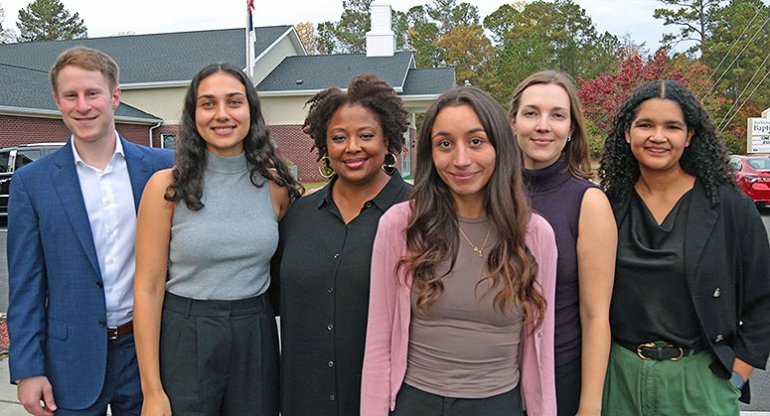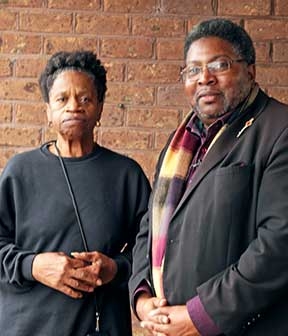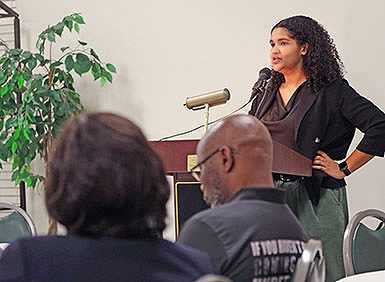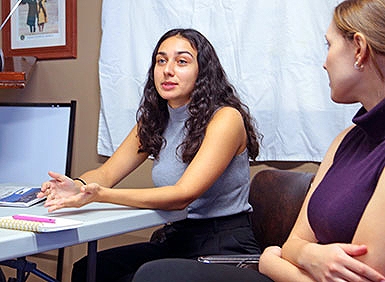Route to Justice
South Carolina wants to build a road through a historic Black neighborhood over residents’ objections. NYU Law’s Civil Rights and Racial Justice Clinic is teaming up with community members to put the brakes on the project.
Early on a Friday evening in Conway, South Carolina, local residents are finishing up a communal dinner in the fellowship room of a church. After chatting and laughing over home-cooked jambalaya and sweet potato casserole, they shift their attention to four law students, who take turns at the lectern addressing the crowd.
Mariana Lopez ’24, Deborah Merino ’24, Ola Topczewska ’24, and Ry Walker ’24—all students in NYU Law’s Civil Rights and Racial Justice Clinic—traveled to Conway in November to work on a case involving Sandridge, a historic Black neighborhood in Conway that dates back to the 19th century. Sandridge’s residents learned in 2019 that the South Carolina Department of Transportation (SCDOT) and Horry County had decided to build a four-lane road through their community—cutting them off from their local grocery store, their churches, and one another. Sandridge’s residents turned to the South Carolina Conference of the NAACP, which then reached out to the clinic to help in 2021.
Watch a video about the clinic's trip to South Carolina:
The clinic is pursuing a two-pronged legal approach. A previous cohort of students in the clinic filed a Title VI complaint under the Civil Rights Act of 1964 with the Federal Highway Administration (FHWA), a division of the US Department of Transportation (USDOT), alleging that the road discriminates against Black residents. If FHWA reaches a finding of discrimination, it could pull federal funding from SCDOT. The clinic also helped initiate a separate investigation by the US Army Corps of Engineers into the potential environmental harms from filling in wetlands to construct the road.
The students have convened this Friday evening town hall to update community members about the case’s status and to field questions. They distribute preprinted postcards addressed to officials at USDOT, FHWA, and the Army Corps, and invite residents to fill out and mail the postcards to make their voices heard. Their Conway trip also includes meetings with community activists and affected residents as well as a local reporter. Before returning to New York, the students will visit local churches to hand out more postcards to congregation members as part of an organizing strategy that aims to highlight the breadth of opposition to the road.
The disproportionate negative impact of highway construction on Black communities is a phenomenon familiar to Deborah Archer, Margaret B. Hoppin Professor of Clinical Law, who co-teaches the Civil Rights and Racial Justice Clinic with Joseph Schottenfeld, assistant general counsel of the NAACP. Archer has produced significant scholarship about the tragic history of transportation injustice in the United States. The clinic has engaged with the issue previously in Syracuse, New York, as officials determined how to deal with an aging stretch of elevated highway that had disrupted a once-vibrant Black neighborhood in the 1960s.
“Our interstate highway system was built in a way that kind of locked in racial segregation,” says Archer. “Sometimes it was built right through a Black community because they were the path of least resistance—destroying homes and communities; uprooting businesses, schools, community institutions. Sometimes that highway was built to encircle the Black community…becoming a wall that separated the Black community from other communities.”
On the chilly gray morning after the town hall, the students accompany Reverend Cedric Blain-Spain as he treads through wet cemetery grass to point out an eroded tombstone bearing the name of Hannah Hemingway, his seven-times-great-grandmother (1829-1904). Blain-Spain, a community activist in Sandridge, is spearheading the residents’ challenge to the road project. He explains that his ancestor was considered “one of the mothers of Sandridge,” a community in which most people are closely related to one another. Many of their forebears are buried in this graveyard, directly across a two-lane highway from Hemingway Chapel AME Church, founded in 1882.
One of the original proposed routes for the new highway, called the Conway Perimeter Road, would have cut right through the cemetery. “We’re here because they’re our ancestors, and there would be no us if it weren’t for them,” says Blain-Spain. “So we’re left to protect them and their legacy and their resting spot.”
As it is, the Conway Perimeter Road, which would connect two existing highways via a route running straight through Sandridge, is estimated to displace at least six families and divide the neighborhood. Other potential routes would have spared Sandridge, but at the expense of majority-white communities. Blain-Spain and his neighbors suspect that the disruption of their community was seen as an easier political sell.
The irony, they say, is that even SCDOT did not deem the Conway Perimeter Road a priority; it was ranked 59th on a list of potential projects. Further, the road would have the greatest benefit for recreation-seekers headed to nearby Myrtle Beach.
The road project is not the first time Sandridge has borne the detrimental effects of new infrastructure. Plans are underway to expand an electrical substation. And residents were already challenging the building of a gas pipeline through their community when they discovered that the Conway Perimeter Road was also in the planning stages.
Like other local residents, Carmella Spain, whose family has dealt with both the pipeline and the road, experienced continual pressure from acquisition agents who were hired by SCDOT and the county to purchase the property in the proposed highway’s path. Spain and other neighbors eventually accepted a fraction of fair market value.
“It hurts my family to the core to have lost property that has been in the family for over 50 years,” says Spain. “And now here we are for a road that…has no purpose, in my opinion…. You took away our home, our community, our land. We have nothing now.”
The Civil Rights and Racial Justice Clinic became involved in the Sandridge case through its client, the NAACP’s South Carolina State Conference. Brenda Murphy, the president of the conference, describes the displacement of Black communities by highway projects as a statewide problem.
“Highways have been an issue—a challenge—for many, many years here in South Carolina,” says Murphy. “I think it’s just about every area you can find where highways have been disruptive to people of color…. [People] are being pushed further outward from where they were accustomed to living more in the inner city. They can’t afford to live in the city anymore.”
The first group of NYU Law clinic students to tackle the Sandridge case began their work in Fall 2021. The clinic’s initial Title VI complaint was rejected by FHWA on jurisdictional grounds, but students successfully submitted an appeal that showed how federal funding was enabling the construction of the road. The complaint was accepted for investigation in January 2023. The clinic has since continued with fact-finding to assist USDOT in its investigation, and checks in with the agency regularly.
Archer says persuading USDOT to undertake a Title VI investigation is a rare achievement. “We have many other advocates around the country who are reaching out to the clinic to see if they can learn from the strategies that we employ to get their investigations open, or to see if we can join their teams and help them to push forward,” says Archer. “I think a lot of people who have worked and advocated in this space for a long time themselves have been impressed with the work that the students have done.”
The clinic also worked to trigger a second investigation by the Army Corps, which must grant a permit for the construction of the road under the Clean Water Act because it involves filling in wetlands. Sandridge residents were already grappling with flooding that had been exacerbated by the building of two wealthy, majority-white subdivisions. (A powerful storm system that hit Sandridge in mid-December caused widespread flooding once again.) The loss of the wetlands could only worsen the problem. Without the permit, construction cannot begin. The clinic is offering the same kind of support to the Army Corps’ ongoing investigation that it has given to USDOT’s. Both investigations are still in progress.
“There’s a lot that could be done with this [road construction] money that can help a community that’s now devastated by the impact of flooding and other environmental issues,” such as decreased air and water quality, says Blain-Spain.
For the students, one of the clinic’s biggest lessons is the importance of holistic representation that goes beyond courtroom advocacy. “Understanding that the law is never going to be the solution on its own, but always as a part of a larger structure and engagement with community, is one of the main takeaways I'll have from this clinic,” says Ry Walker.
Ola Topczewska concurs. “It’s been really interesting to see kind of the diversity of tools that are out there for lawyers as they’re pursuing movement work,” she says, “and the way that they can incorporate the stories and perspective of the community directly in those efforts.”
Mariana Lopez contrasts her clinical work with studying civil rights law in a doctrinal course. “We learned about the black-letter law, what it was,” she explains. “But we didn’t learn how to apply the law to our practice. And I came into the clinic just a semester later, and I was able to actually work on a Title VI complaint and work with community members in pushing for a finding of discrimination.”
Deborah Merino says that the guidance of co-teachers Archer and Schottenfeld, whom she calls “exceptional advocates,” particularly inspired her: “To get to learn from them and then have their vote of confidence when we are tackling these huge legal problems as students makes me feel like I’m capable of taking this on.”
Archer suggests that the learning goes both ways. “They bring in a fresh set of eyes, a new set of questions, new perspectives that help us move the work in new directions, deeper in some directions that we were going in before, but in new and innovative ways,” she says. “And I love that. I think it helps the case become stronger, and it helps me grow as an advocate.”
While these four students have completed their time in the clinic, new students will continue the work, and more visits to Sandridge will follow. The members of each successive cohort, says Blain-Spain, “have been very thorough in their knowledge of what they’re doing, and what they’re not knowledgeable about, they’re willing to learn it. They get back with us. And so this has been certainly a blessing to us and a great help to the Sandridge community…. Their service is worth $1,000,000 an hour.”
Posted January 22, 2024





